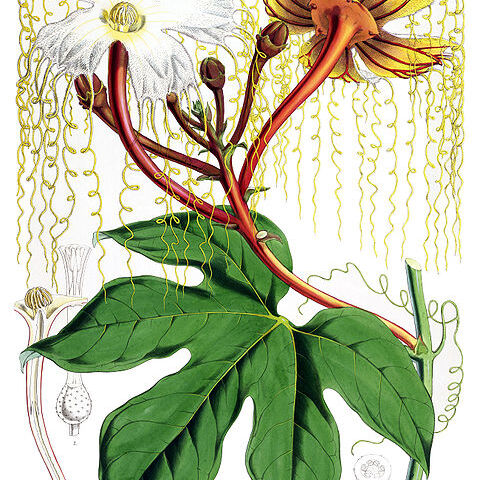Herbs, annual or perennial, or weak, woody shrubs with watery sap, scandent or prostrate. Roots fibrous or tuberous. Stem often angular. Leaves alternate, undivided or variously palmately or pedately divided, often cordate; tendrils solitary, lateral, simple or branched, spirally twisted, rarely absent; stipules absent. Plants monoecious or dioecious; flowers unisexual, very rarely bisexual; flowers paniculate, racemose, or subumbellate, rarely solitary. Calyx tube (hypanthium) adnate to ovary; tube rotate, campanulate, or saucer-shaped, usually 5-lobed; segments imbricate. Corolla usually sympetalous, inserted on calyx tube; segments valvate or involute. Stamens inserted at base or mouth of calyx tube, usually 5 or 3, of which one often 1-celled and other two 2-celled; filaments separate or variously united into a column; anthers separate or coherent into a head; anther cells straight to conduplicate, extrorse; rudimentary ovary often present in male flowers; staminodes often in female flowers. Ovary inferior or nearly completely so, mostly composed of 3 carpels, 3-locular, rarely 1-or 2-or spuriously 4-6-locular; ovules usually numerous, rarely few or solitary, horizontal, pendulous, or ascending, often immersed in pulp; placentas parietal, fleshy, often confluent at middle of ovary; style terminal, simple or branched at apex or styles free; stigma enlarged or 2-fid. Fruit usually a fleshy berry or corky, indehiscent or rarely opening by valves or by an operculum, rarely fibrous. Seeds often numerous, rarely few or solitary, horizontal, pendulous, or ascending, often compressed, rarely winged; endosperm absent; embryo with leaflike cotyledons and short radicle.
Plants usually vines, sometimes shrublike in Cucurbita, or perennial [annual] herbs (Melothria), usually monoecious or dioecious, rarely andromonoecious (Cucumis). Stems prostrate, procumbent, sprawling, trailing, or climbing; tendrils usually present, unbranched or branched. Leaves simple (also compound in Cyclanthera, Momordica), alternate, estipulate, petiolate (sessile or subsessile in Sicyos); blade unlobed or palmately, pedately, or pinnately lobed. Inflorescences paniculate, racemose, umbellate to subumbellate, fasciculate, corymbose, or solitary flowers. Flowers unisexual [bisexual]; sepals (4–)5(–6), sometimes vestigial (Cyclanthera), connate, calyx rotate, campanulate, saucer-shaped, or tubular, adnate to corolla, producing hypanthium; petals 5(–6), distinct or connate, imbricate or induplicate-valvate, usually yellow, orange, or white, sometimes green, margins entire, rarely fimbriate, corolla rotate, cupulate, campanulate, salverform, or funnelform; stamens (2–)3–5, with 4 mostly connate in pairs, appearing as only (1–)3 stamens; anthers connate or distinct, pepos, rarely capsules, elongate to globose, exocarp usually hard, sometimes fleshy and berrylike, glabrous or hairy, smooth or bristly, echinate, aculeate, muricate, tuberculate, or furrowed, indehiscent or dehiscent. Seeds mostly compressed, sometimes winged, arillate in Coccinia, Ibervillea, Momordica, and Tumamoca, exalbuminous; embryos straight.
Monoecious or dioecious herbs, sometimes woody at base, climbing or trailing, mostly bearing tendrils, mostly hairy. Tendrils stipular in position, simple or 2–7-branched. Inflorescences mostly axillary, rarely terminal on lateral branches, paniculate, racemose, fasiculate or flowers solitary. Flowers actinomorphic, mostly unisexual. Hypanthium cupular, campanulate or tubular, shallow to elongate. Calyx mostly 5-lobed. Corolla 5-lobed, or petals 5, free; limb usually more or less rotate. Male flowers: stamens basically 5, inserted on hypanthium and alternate with corolla-lobes, sometimes on basal disc, free or variously united, frequently stamens 3, 2 double and 1 single, or united in a column; anther locules straight, hooked, curved or flexuose, duplicate, triplicate or contorted, free, cohering or united; disc present or absent. Female flowers: ovary inferior, 1–3-locular, of usually 3 united carpels; ovules 1 to many; placentation parietal, rarely axile, basal or apical; staminodes present or absent. Fruit fleshy or dry, berry, pepo or capsule, indehiscent or dehiscent. Seeds 1 to many, large, often compressed, sometimes winged; embryo large; endosperm absent.
Female flower: calyx-tube adnate to the ovary and often produced beyond it; staminodes usually not present; ovary inferior or very rarely free; placentas often 3, parietal but often meeting in the middle; ovules numerous, rarely few, arranged towards the walls of the ovary; style simple or rarely 3 free styles; stigmas thick
Male flower: calyx tubular, lobes imbricate or open; corolla polypetalous or gamopetalous, lobes imbricate or induplicate-valvate; stamens free or variously united, mostly 3, rarely 1–5, one anther always 1-celled, the others 2-celled, cells straight or often curved, flexuous or conduplicate, connective often produced
Flowers unisexual, epigynous, monoecious or dioecious, axillary, variously arranged, the female commonly solitary. Glandular bract-like structures (probracts) sometimes present at base of peduncles
Stamens basically 5, androecium always variously modified, commonly appearing as 2 double stamens and 1 single stamen, free or variously coherent or united; antherthecae often convoluted
Scandent or prostrate tendriliferous annual or perennial herbs or less often woody lianes, rarely erect herbs without tendrils, often with tuberous rootstock
Ovary inferior, unilocular or sometimes 3-locular, of usually 3 united carpels; placenta-tion parietal, rarely axillary, placentae often intrusive
Tendrils lateral to the petiole base, simple, distally 2-fid or proximally 2–7-fid, rarely reduced to spines or absent, usually 1 at each node
Herbs or rarely undershrubs with watery juice, often scabrid; stems scandent or prostrate; tendrils mostly present, spirally coiled
Fruit a dry or fleshy capsule, berry or hard-shelled pepo, variously dehiscent or indehiscent, rarely a 1-seeded samara
Ovules anatropous, 1-many, horizontal, pendulous or ascending; style 1, with 2 or usually 3 stigma-lobes, or styles 3
Seeds 1-many, rather large, often compressed, sometimes winged; embryo large; endosperm absent
Flowers monoecious or dioecious, very rarely hermaphrodite, actinomorphic
Receptacle-tube shallow to tubular, usually 5-lobed, lobes usually small
Petals usually 5, free or variously united, corolla mostly regular
Leaves alternate, palmately veined, simple or pedately compound
Seeds various, often flattened, without endosperm
Staminodes often present in female flowers

